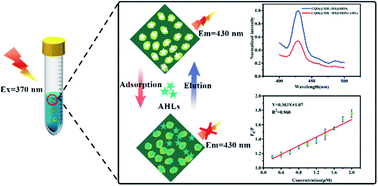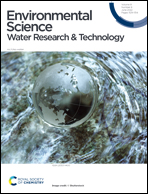Sensitive detection of quorum signaling molecules (N-acyl homoserine lactones) in activated sludge based on surface molecularly imprinted polymers on CQDs@MIL-101†
Abstract
N-Acyl homoserine lactones (AHLs), as typical signaling molecules in quorum sensing systems, play a key role in identifying the performance of activated sludge and microbial activities. Herein, a molecularly imprinted polymer composite material (CQDs@MIL-101@MIPs) was prepared under controlled conditions using a metal–organic framework (MIL-101) as the carrier material, carbon quantum dots (CQDs) as the fluorescent probe, and 2,5-dimethyl-4-hydroxy-3(2H)-furanone (DMHF) as the template molecule by a surface imprinting technique, which was utilized for the rapid and sensitive detection of activated sludge quorum-sensing signaling molecules. After the elution of the template molecules, blotted cavities capable of selectively recognizing AHLs were formed on the surface of CQDs@MIL-101@MIPs. This composite material showed a linear fluorescence intensity with different target concentrations; the linear detection range was 0.2–2.0 μM, and the limit of detection (LOD) was 0.21 μM. The fluorescence method based on CQDs@MIL-101@MIPs was utilized to detect and analyse activated sludge samples with recoveries of 95.2–117.9%. As a stable and straightforward detection method, the CQDs@MIL-101@MIPs based fluorescent sensor has the potential to be utilized for the rapid and sensitive detection of AHLs in real samples.



 Please wait while we load your content...
Please wait while we load your content...